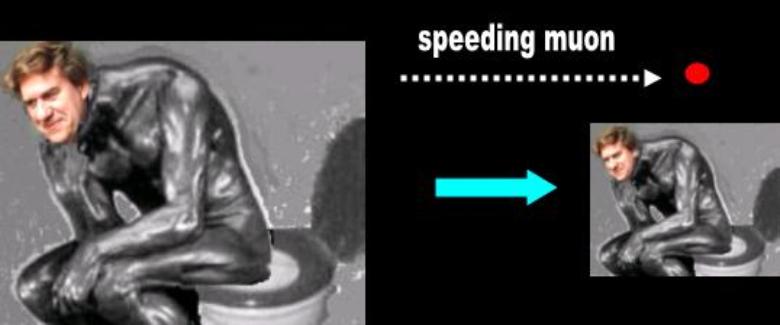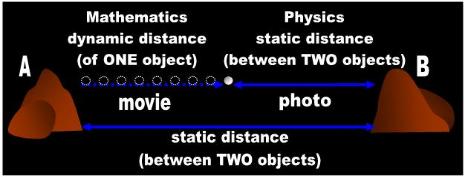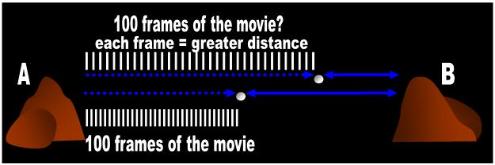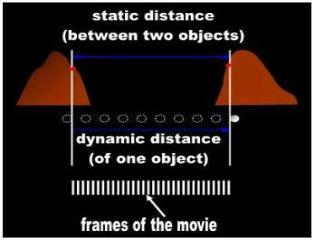| Adapted for the Internet from: Why God Doesn't Exist |
| Contraction from the traveler's perspective: Relativists say that a speeding muon draws two mountains together |
- 1.0 Length, distance, or distance-traveled?
Relativists claim that a muon traveling at near-c proves the length contraction explanation of Special Relativity. We must first
settle whether the bozos are talking about length, distance, or distance-traveled. Apparently, the mathematicians are talking
about distance-traveled, calling it distance, and claiming that they have proven length contraction. What an incongruous mixture!
- 2.0 Traveled or will travel?
In addition, there are two irreconcilable physical interpretations of the muon length contraction theory and relativists unwittingly
invoke both of them during a given presentation. One has to do with explaining what happened to a muon that has already
traveled and reached its destination. The other situation has the muon still traveling towards its destination. Relativists go back
and forth between these different scenarios and, predictably, end up covering all the bases and answering every question.
Here I analyze them separately in order to expose this contradiction.
3.0 Have distance, will travel
Let's assume that there are two mountains and somewhere between them a muon traveling from Mount A to Mount B (Fig. 1).
(We could also assume that the muon is traveling from peak to valley of one mountain and discuss how the mountain flattens,
but this setup will be easier for the reader to understand.) In the context of a speeding muon, the mathematician is analyzing the
distance from the last location of the muon to Mount B at a particular cross-section of time. He is saying that the distance in the
direction of travel of the muon (i.e., towards Mount B) shrinks from the muon's perspective. The mathematician is referring to
the distance the muon has yet to travel. This part of the movie hasn't happened yet. We are staring at a photograph of a gap
between the muon and Mount B and the mathematician is predicting that this static distance will shrink.
But there is already a built-in assumption. The assumption is that the muon is traveling at near-c away from Mount A. The muon
is standing still in the last frame of the movie, but the context is that this is merely the last frame of our film. We are staring at the
last frame of a movie that has yet to finish.
The distance the muon has yet to travel is the static distance of Physics. The distance of Physics is the separation between two
objects, in the instant case, between the muon and Mount B. The distance the muon already covered is the dynamic distance-
traveled of Mathematics. This distance-traveled consists of a movie of the muon at successive locations with respect to Mount A
(actually with respect to its now vanished origin) (Fig. 1). Relativists claim that the distance that shrinks is the static distance of
Physics (between the muon and Mount B) and not the distance-traveled of Mathematics (between the muon and Mount A):
- " The distance to be traveled by the muon from the upper atmosphere to sea
level is physically shorter than the same distance measured by a slower
moving particle." [1]
- In other words, the idiot of Mathematics tells you that his equation 'predicts' that the muon will be closer to Mount B than
warranted by its speed because this distance for some reason is now thinner. However he justifies the contraction of this
distance with the speed the muon has traveled so far! The mathematician uses the distance-traveled behind the muon to
predict something about the static distance in front of the muon. He uses the movie of the muon traveling from Mount A as
the basis to make this argument for why the distance between the muon and Mount B in the photograph will shrink. This is
really frightening! I mean ... suddenly you realize that you are all alone with this guy and you thought he was the doctor of
the asylum. It turns out that he is just one of the patients.
Fig. 1 Distance (Phyz) vs. Distance-traveled (Math) |
| The distance between the photon and Mount B is the static distance of Physics: a gap between TWO objects. It is the distance the particle has yet to travel. This is the distance the idiots of relativity claim that shrinks. |
Fig. 3 More frames or greater distance? |
| The distance they explain their theory with, however, is the distance the particle already covered from Mount A. This mathematical 'distance-traveled' consists of a movie of ONE object and is measured with a clock (vertical distance); not with a caliper (horizontal distance). |

| Bad Beans Bill |



| suffering from special relativistic contractions because of a little muon |
Fig. 2 Distance (Phyz) vs. Distance-traveled (Math) |
| Relativists claim that because a particle called a muon travels at near the speed of light, the distances in its direction of travel shorten. Let's spell out what the idiots of relativity are saying so that there is no misunderstanding. The mathematicians are saying that if a ball travels from one mountain to another at near-c, the mountains come closer to each other (Fig. 2C) |
| The error, of course, has its roots in the definition and misuse of the word distance. The idiots of Mathematics confuse distance with distance-traveled (or displace- ment). The distance of Mathematics is a movie of ONE moving object and is measured with a clock. The distance of Physics is a photograph of the gap between TWO objects. The distance of Mathematics is conceptually dynamic and requires a measurement. The distance of Physics is conceptually static and does not even require the presence of an observer. |

| There are only two possibilities. Either the movie of the traveled portion has more frames or each frame of the movie represents a greater distance. The mathematicians have no justification for either scenario. Both of them imply that the static distance between the mountains shrunk. |
4.0 The FTL muon
If the muon has already crashed against Mount B, the mathematicians are not predicting anything. They are in retrospect
explaining what happened. A scientific theory is one which explains what happened and not one that makes predictions.
Predictions are the stuff of astrologers, palm readers, and relativists. Therefore, this version is at least more compatible
with Science than the one we just covered. Under this scenario, the distance that relativists are invoking is not the static
separation of Physics. Here they are talking exclusively about the distance-traveled by the muon from Mount A to Mount B.
This implies that the 'physical' distance (the static gap) between the mountains has suffered no change.
The first thing that this compels relativists to concede is that the distance-traveled that they measure in the religion of
Mathematical Physics is necessarily different than the static distance of Physics. We leave the qualitative distance
completely out of the discussion and, if there are any valid conclusions, they will relate solely to the number of frames
in a film.
So what are they saying?
Relativists are in effect proposing that their muon film does not consist of 150 frames, but of 100 (Fig. 3). And here there
are two possibilities. Either each frame represents the same distance and some frames are missing (Fig. 3 A) or somehow
each frame unjustifiably now represents more distance (Fig. 3 B). This last scenario again is a case for the psychiatrists.
The implication is that static distance increased within a photograph.
What rational justification can the mathematicians offer for this physical phenomenon? The muon had to cover the entire
distance from one mountain to the next because the mountains certainly did not come closer to each other. So how does
a muon skip a stretch of distance and manage to come closer to Mount B? By what physical process? Without a physical
interpretation, relativists have absolutely nothing. They are mathematically describing a phenomenon they still don’t
understand.
5.0 The real problem with Einstein's length contraction theory
The fundamental problem with the Lorentz-Fitzgerald length contraction theory is that for the last 400 years the morons of
Mathematics have modeled all of their equations with corpuscles. If there are no such things as particles in the entire
Universe, the theoretical work accumulated in the last century at college think tanks and high tech accelerators is totally
worthless! None of it survives! If there are no discrete particles in the Universe, not only does the irrational theory of
Quantum Mechanics die a sudden death, but with it General Relativity, Special Relativity, and String Theory as well. If the
phenomenon that the mathematical physicists call 'the muon' is not mediated by a particle, we have to erase the
blackboards on Earth and start all over.
The mathematicians may accuse be of being crazy. They'll argue that they have been able to describe what they observe
and predict its behavior.
A description alone does not constitute Science. Anyone can describe without understanding anything, and that is the
status quo in relativity. If what Einstein's idiots are modeling with equations is not a particle, but rather a torque signal
propagating along a rope, their physical interpretations are what we should discard! The mathematicians can just as
well use their stupid equation with the torque signal model and reach completely different conclusions. It is their
supernatural conclusions which are wrong! The problem with the muon length-contraction proposal is that the muon
is not a discrete particle. For the last 400 years the mathematicians have been staring at a torque signal propagating
along a DNA-like entity and calling it a particle. All the particles of the Standard Model of Quantum Mechanics are
different behavioral aspects of the twined electromagnetic rope.
The first question a mentally sane person asks is whether the static distance between the two mountains will also shrink.
Does the static ‘physical’ distance between two mountains decrease because a muon travels fast between them (Fig. 2)?
Are the mathematicians going to measure the dynamic distance-traveled of the muon with a clock and the static distance
between the clouds with a caliper? Are they going to apply inconsistent standards, one to measure distance-traveled by
ONE object (mathematical distance) and another to measure the distance between TWO objects (physical distance)?
The mathematicians answer that the static distance between the two mountains does in fact shrink:
- " the atmosphere is length contracted by a factor of 1/γ = 1/71. From the muon's
perspective, the atmosphere is so thin that it can easily reach the ground." [2]
- In fact, this must be so if the effect is real and the mathematicians say the effect is real because otherwise the muon does
not make it to Earth! The stupid idiots are literally saying that because an invisible particle travels almost at the speed of
light the Moon moves closer to the Earth! This is exactly what the stupid morons are saying and don't let them tell you
otherwise. Especially, don't let them introduce any equations or numbers into the discussion. There is no need for rulers,
clocks, or calculators. This is strictly a conceptual issue.
So let's cut the crap and go directly to the extreme case. If the two mountains are not moving with respect to each other,
is this distance different than the distance covered by the muon from Mount A to Mount B?
Renshaw say it is. He says that the distance experienced by the muon is shorter than the distance experienced by a particle
sitting on one of the mountains. What the morons of Mathematics have done is superpose a movie on a photograph.
According to their ridiculous length contraction equation, the static gap separating the muon from Mount B will shorten,
but the value they put in their equation is the dynamic distance they measured between the muon and Mount A (actually,
between the muon and its starting location: motion is defined for a single object). From a conceptual point of view, there
may be a chance to shorten mathematical distance-traveled, perhaps if God waves His Holy Wand and makes a few frames
of the film disappear. There is absolutely no chance to shorten static distance between two objects within a given frame of
the Universal Movie! This 'physical' distance is immovable. The day that a tree moves closer to a rock within the photograph
you're holding in your hand, you really ought to visit either the ophthalmologist or your psychiatrist. It borders on
Down's Syndrome to say that the distance between the two houses in the photograph shrunk!
The distance-traveled contraction theory of Special Relativity is also self-defeating. It violates the fundamental principle of this
sect which states that nothing can travel faster than light:
- • if the muon is physically closer to Mount B or crashed against it,
• and this decrease in distance is not a cosmetic phenomenon (for otherwise
- the mathematician claims he would not be able to detect muons at sea level)
- • and if the static physical distance between the mountains did not shrink
- (for otherwise the mathematician needs to see a psychiatrist)
- • then the muon is necessarily further away from Mount A the moment it
- crashes against Mount B
But how can this be if there is no more and no less distance between the two mountains. The two mountains were unaffected
by the muon's behavior. What changed according to relativity is the location of the muon with respect to Mount B. But this
claim focuses the camera on Mount B without regards to what happened between the muon and Mount A. If the muon is
farther away from Mount A at any given moment we are back to the distance/distance-traveled scenario.
The bottom line is that distance-traveled has nothing to do with the real world. It is a convenient technique to quantify
‘distance’ using length. The mathematicians have lost sight of this and this is the reason they reach irrational conclusions.
They will not be able to escape the predicament that something somewhere moved faster than the speed of light! This is
not an issue of measurement. It is strictly a conceptual issue.
A
B
- Module main page: Relativists don't understand the difference between distance and distance-traveled
Pages in this module:
- 1. What do relativists mean by length contraction?
2. My ruler can contract, but not its length!
3. None of the three length contraction versions of relativity are rational
- a. Contraction from the traveler's perspective:
This page: Relativists say that a speeding muon draws two mountains together
- b. Contraction from the observer's perspective:
SR contradicts GR
c. Real contraction:
We don't prove contraction with equations or experiments
- ________________________________________________________________________________________
- Copyright © by Nila Gaede 2008
